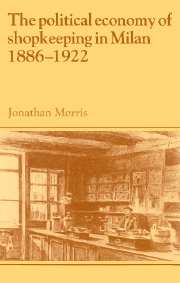Book contents
- Frontmatter
- Contents
- List of figures
- List of tables
- Acknowledgements
- Introduction: shopkeeping as a historical problem
- 1 The business of shopkeeping in Milan, 1859–1915
- 2 The context of shopkeeping: trades and techniques
- 3 The economic geography of shopkeeping: the role of the dazio consumo
- 4 The esercenti enter the political arena
- 5 Constructing the esercenti movement, 1886–1890
- 6 The esercenti and the depression, 1890–1897
- 7 Shopkeepers, cooperatives and the politics of privilege
- 8 Milan and the national small-business movement, 1886–1898
- 9 The allargamento debate, 1895–1897
- 10 The end-of-century crisis and the enlargement of the dazio belt
- 11 Shopkeeping in the new century
- 12 Labour relations and class politics
- 13 The esercenti and the centre-left administration, 1900–1905
- 14 Shopkeepers and Socialists 1905–1922
- Conclusion: identity and autonomy
- Bibliography
- Index
- Past and Present Publications
9 - The allargamento debate, 1895–1897
Published online by Cambridge University Press: 24 November 2009
- Frontmatter
- Contents
- List of figures
- List of tables
- Acknowledgements
- Introduction: shopkeeping as a historical problem
- 1 The business of shopkeeping in Milan, 1859–1915
- 2 The context of shopkeeping: trades and techniques
- 3 The economic geography of shopkeeping: the role of the dazio consumo
- 4 The esercenti enter the political arena
- 5 Constructing the esercenti movement, 1886–1890
- 6 The esercenti and the depression, 1890–1897
- 7 Shopkeepers, cooperatives and the politics of privilege
- 8 Milan and the national small-business movement, 1886–1898
- 9 The allargamento debate, 1895–1897
- 10 The end-of-century crisis and the enlargement of the dazio belt
- 11 Shopkeeping in the new century
- 12 Labour relations and class politics
- 13 The esercenti and the centre-left administration, 1900–1905
- 14 Shopkeepers and Socialists 1905–1922
- Conclusion: identity and autonomy
- Bibliography
- Index
- Past and Present Publications
Summary
During the last five years of the nineteenth century, both city and shopkeeper politics in Milan passed through their most turbulent phase since the flight of the Austrians in 1859. The municipality's search for a way to raise the revenue necessary to provide amenities for the city's burgeoning population, at a time when rapid inflation masked the beginnings of an economic recovery, lay at the root of the problem, and the system of the interno and esterno again came under threat. Milan's situation contributed to the ‘end-of-century’ crisis in which the legitimacy of Italy's existing political system was challenged by a combination of public disorder, economic distress and the development of viable political alternatives on the left. Disagreements over the best strategies to adopt in these circumstances led to the emergence of several divisions in the esercenti camp, reflected by the growth in shopkeeper splinter groups and news-sheets shown in Tables 9.1 and 9.2.
ESERCENTI POLITICS, 1895–6
The first of these disputes was that between the Federation and L'Esercente, which, it will be recalled, developed during the lead-up to the elections of 1895. At the heart of the issue lay the question of the movement's political autonomy. The newspaper attacked the Federation as a nest of Republicans, asserting that it would never succeed in eliminating cooperative privileges whilst it remained so closely allied to the Democratic bloc.
- Type
- Chapter
- Information
- The Political Economy of Shopkeeping in Milan, 1886–1922 , pp. 176 - 191Publisher: Cambridge University PressPrint publication year: 1993

